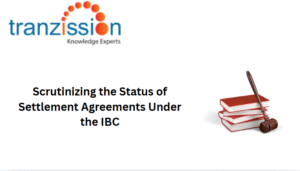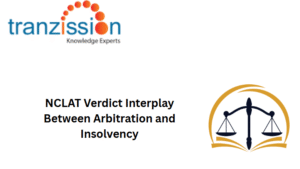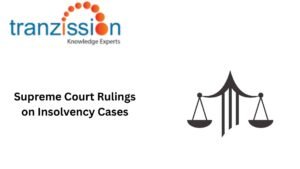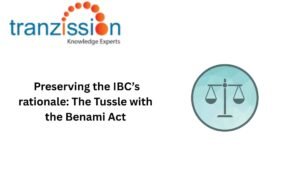
How to draft a resolution plan under IBC?

Table of Contents
As per the resolution plan under IBC submitted by the insolvency professional, the Committee of Creditors and the Adjudicating Authority can decide whether the company is to be liquidated. Understanding the exact format of a resolution plan under IBC is crucial to ensuring the success of the resolution process, which may lead to the financially distressed company being revived, rehabilitated, or restructured as per the decision of the Adjudicating Authority
What is a Resolution Plan?
Under the Insolvency and Bankruptcy Code, 2016 (IBC), a resolution plan is a comprehensive document drafted by the resolution applicant for the insolvency resolution of the corporate debtor as a going concern during the liquidation proceedings, as defined under section 5(26) of IBC. This resolution plan under IBC needs to be approved by the Committee of Creditors (CofC) and the Adjudicating Authority, the National Company Law Tribunal (NCLT). It is first approved by the CoC as under section 30(4) by not less than 66% vote, and then moves forward to either be rejected or approved by the NCLT. If the plan is approved, the NCLT passes an order, which as per section 31(1) is binding on the employees, members, creditors, authorities, guarantors, and other stakeholders. However, if rejected, the aggrieved party can file for an appeal under section 32 or the NCLT will initiate the liquidation proceedings under section 33 of IBC. Read related article Conflict of Jurisdiction between NCLT and Civil Courts
Profile of the Resolution Applicant
The resolution applicant plays an important role in submitting the resolution to the RP. As per Regulation 39(1)(a) of the Insolvency and Bankruptcy Board of India (Insolvency Resolution Process for Corporate Persons) Regulations, 2016 (hereon forward known as CIRP Regulations), the resolution applicant must also submit an affidavit of its eligibility.. It is necessary that for an individual to be a resolution applicant, the individual not be ineligible as per the conditions given under section 29A of IBC:
- An undischarged insolvent
- A wilful defaulter under the guidelines of the Reserve Bank of India issued under the Banking Regulation, Act 1949
- Has an account or an account of a corporate debtor classified as a Non-Performing Asset when at least a period of 1 year has lapsed from the date of the classification.
- Has been convicted of an offence for either 2 years under any Act, or for 7 years or more under any law
- Has been disqualified to as a director under Companies Act, 2013
- Has been prohibited by the Securities and Exchange Board of India from trading in securities or accessing by the securities market.
- Any person who is a promoter, manager, or in control of the corporate debtor who is involved in any avoidance or fraudulent transaction.
- Has executed a guarantee in favour of the creditor against which an application for the insolvency resolution is made by the creditor, which is invoked by the creditor and is unpaid in full or part.
- Subject to any disability under any law in a foreign jurisdiction
It is important that the resolution applicant not fall under any of these categories. The resolution applicant must also have the capability to implement the resolution plan under IBC in the plan itself.
Details to be included in the Resolution Plan
Regulation 37 of the CIRP Regulations provides a list of measures for the insolvency resolution for maximisation of the value of assets however, this list is not exhaustive:
- Transfer of all or parts of the assets of the corporate debtor to one or more persons
- Sale of all or part of the assets
- Restructuring of the corporate debtor through merger, amalgamation and demerger
- Substantial acquisition of shares of the corporate debtor,
- Cancellation or delisting of any shares of the corporate debtor
- Satisfaction or modification of any security interest
- Curing or waiving of any breach of the terms of any debt due from the corporate debtor
- Reduction in the amount payable to the creditors
- Extension of a maturity date or change in interest rate or other terms of a debt due from the corporate debtor
- Amendment of the constitutional documents of the corporate debtor
- Issuance of securities of the corporate debtor
- Change in the portfolio of goods or services produced or rendered by the corporate debtor
- Change in the technology used by the corporate debtor
- Obtain the necessary approvals from the Central and State governments and other authorities
- Sale of the debtor’s assets to resolution applicant (s)
Mandatory Contents of the Resolution Plan
The resolution applicant submits the resolution plan under IBC with information which is necessary to be included in the plan that is prepared according to the information memorandum as per section 30 of IBC. The mandatory contents of the resolution plan is specified under Regulation 38 of the CIRP Regulations:
- The amount payable under the resolution plan: the amount payable to the financial creditor over the operational creditor and the amount payable to financial creditors who did not vote in favour of the resolution plan under IBC.
- A statement that explains the stakeholder’s interests in the resolution plan under IBC
- The term and implementation schedule of the resolution plan under IBC
- The debtor’s management and control of the business during the resolution plan under IBC and adequate means for supervising its implementation.
- The resolution plan under IBC must demonstrate the cause of default, that it is feasible and viable, provisions for its effective implementation, provisions for approvals required and the timeline the resolution applicant has the capability to implement the resolution.
- Only if it is required, the CoC may consider the requirement of a monitoring committee to implement the resolution plan under IBC.
Preparation and Submission of the Resolution Plan
As per section 25(2)(h) of IBC, the resolution professional (RP) has the duty to invite an Expression of Interest from the resolution applicants. It is necessary that the resolution applicant not be ineligible as section 29A of the IBC. The RP also has the duty to prepare an information memorandum as per section 29 of IBC and Regulation 36 of the CIRP Regulations that is to be submitted to the resolution applicant, which is necessary for the resolution plan under IBC. The RP also prepares a Request for Resolution Plan (RFRP) which provides for the manner in which the entire corporate insolvency resolution process (CIRP) will proceed. The RP shall within 5 days of the date of issue of the final list make a request for resolution plan (RFRP). The RFRP allows for prospective resolution applicants a minimum of 30 days to submit the resolution plan. [3] Under Regulation 40B, the RP has to submit Form CIRP 4 within 7 days of the issue of the RFRP, which includes the expression of interest, RFRP and its modification, evaluation matrix and its modification, non-compliance with the provisions of IBC, and other laws that are applicable to the corporate debtor. The CoC must approve the resolution plan under IBC by 66% of the financial creditor’s vote.[4] The RP should submit the resolution plan under IBC approved by the CoC to the NCLT at least 15 days before the 180 days period under section 12 with the certificate in Form H of Schedule I and the evidence of receipt of performance security as stated in Regulation 39(4) The final step for its acceptance for the resolution plan’s success is the NCLT’s approval.[5] Under Regulation 39(5A) the RP should intimate each claim, the principle or formulae the payment of the debts under each resolution plan under IBC within 15 days of the NCLT’s order.
Execution of the Resolution Plan
According to Regulation 39(1A), the resolution applicant has to sign and date any and all documents submitted. The RP must provide the manner in which the business operation of the corporate debtor during the insolvency resolution period. [6] The resolution plan under IBC must also include the standards for supervising the implementation. These include how the RP will handle avoidance transactions, such as preferential, undervalued, and exorbitant transactions. The resolution applicant has submitted an affidavit stating that the resolution applicant is not ineligible under section 29A of IBC.[7] The RP has to submit Form CIRP 4 which includes the expression of interest, RFRP and its modification, evaluation matrix and its modification, non-compliance with the provisions of IBC, and other laws that are applicable to the corporate debtor, within 7 days of the issue of the RFRP. It is necessary for the CoC and the NCLT to approve the resolution plan under IBC. If the resolution plan under IBC is not satisfactory according to the NCLT, it is liable to be rejected.
Terms of Resolution Plan
It is necessary for the resolution plan under IBC to include, but not be restricted to the:
- Treatment of liabilities not received or admitted by the RP
- Treatment of contingent liabilities
- Extinguishment and waiver of other claims and liabilities
- Novation of debts
- Treatment of debts barred by limitation
- Treatment of employees
- Treatment of subsidiaries
- Desired reliefs and concessions
- Treatment of specific contracts
- Treatment of auditors, corporate governance implementation in corporate post-acquisition
- Treatment of personal guarantees of existing promoters
- Listing or delisting of shares
- Merger or demerger of corporate debtor
- Change in company secretary/ KMPs
- Condition in delays in stock exchange filing/ annual general meetings, finalisation of the audited balance sheet, and other compliances.
- Completion of formalities for registration of title deeds or lease deeds.
- Taking control of assets of the corporate debtor not in its possession
- Releasing assets owned by operational and financial creditors
- Release of amounts, assets, or documents held by the financial creditors in escrow account or trust.
Conclusion
The resolution plan under IBC essentially determines the future of the corporate debtor. Being so significant, it is important that the resolution plan be drafted that includes the interests of the corporate debtor, creditors, and stakeholders as per the IBC as well as the CIRP Regulations. It should be a clear manner for maximising the value of the debtor’s assets while verifying the priority of the financial creditors and the creditor’s claims. If the CoC and the NCLT approve the resolution plan may lead to the company’s successful revival, restructuring, or rehabilitation.





